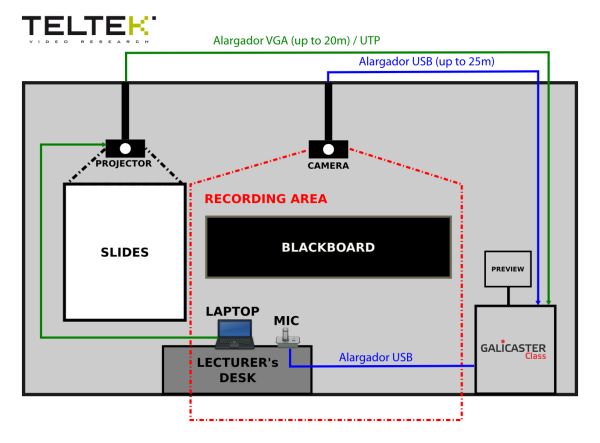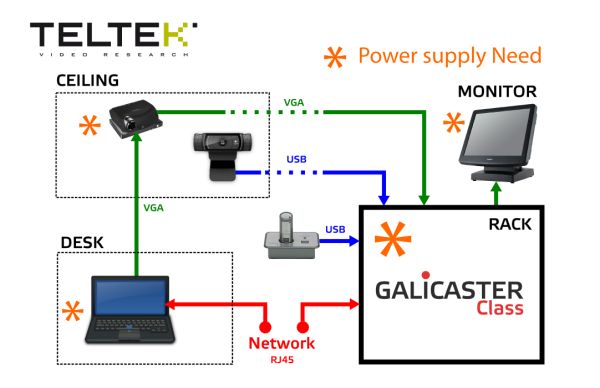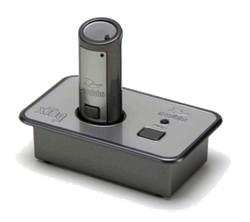IntroductionOn this section you will be guided through a series of steps to finish the setup of your Galicaster Class unit. Please, read this documentation carefully and follow its instructions. In case of doubts please take advantage of the Galicaster Community list to make any question or suggestion. If you have purchased this unit from Teltek Video Research contact us directly through the channels we've provided. In the following sections you will receive instructions on how to connect and configure you Galicaster unit. Some of the sections may not affect you because of the hardware you've installed or the type of installation you made, so ignore them and focus on the ones that matters to you. |
A. Room installation
B. Cards and connectors
The Galicaster Class Units can come equipped with different inputs to fulfil your needs on recording multistream material. Depending on the devices you are about to use you should combine those inputs properly.
Please, take a closer look to the image to identify the ports of each capture card before connecting anything.
d.On-board sound card
| # | Port | Description |
|---|---|---|
| D1 | Line IN | (Recommended) To coOn-board sound cardnnect a mixer or a line level microphone to record, mini-jack 3.5mm. |
| D2 | Headphones OUT | To connect a mixer or a microphone to record, mini-jack 3.5mm. |
| D3 | Microphone IN | To connect a microphone to record, mini-jack 3.5mm. |
d.Power buttons
| # | Button |
|---|---|
| E1 | Power button |
| E2 | Reset button |
C. Operative System setup
Autostart
By default, Galicaster is started automatically as the operative system is loaded. To change this do the following:
- Press Win and write Startup Applications,
- Check out Galicaster to disable the autostart
- Repeat the operation to re-stablish the autostart
You may want to do it using the terminal:
- Delete ~/.config/autostart/galicaster.desktop
To re-stablish the autostart:
- cp /usr/share/applications/galicaster.desktop ~/.config/autostart/
Shortcuts
To configure the operative system supporting Galicaster you may exit Galicaster or change the current desktop. To do so:
a. If the admin mode is activated you can quit on the welcome page, on the quit button on the bottom right corner.
- To access the welcome page you can't be recording
b. If the admin mode isn't active then you can use a keyboard shortcut Ctrl+Shift+Q, to do so the Num Block has to be activated.
c. You may not want to exit Galicaster and still change configuration on the OS, use the combination Ctrl+Alt+Left/RightArrow to switch between desktops (usually four).
To run Galicaster once closed use the Shortcut in the Desktop or press Win and write Galicaster to look for the application launcher.
Network Configuration
To change your IP settings, pleas read this official Ubuntu guideline.
The Network Manager is on the top right corner, Right-button click on the double arrow icon.

D. Capture Devices configuration
Galicaster configuration are specified by two types files: configuration and input profiles.
Depending on your needs you may set different parameters. Consult the Profile Section to know the meaning and possible values of each parameters.
Galicaster records multiple devices synchronously. Each device and its configuration is called a track. A Input Profile is a group of tracks to be recorded together. The most common profiles are:
- Webcam + Slides + Microphone: class.ini
- Webcam + Slides + Microphone + Backup Audio: class_audio_backup.ini
- Video Camera (audio included) + Slides: camera_slides.ini
- HD input (audio included) + Slides: hd_slides.ini
- HD camera + HDMI slides: hd_unit.ini
In these examples, we suppose two streams of video. If you don't want to record the slides, create a new profile without the slides track and remember to change the name of the profile, to avoid confusion.
Now, it's time to configure the cards you've selected and the audio. More information about this matter is available here.
D.1 Epiphan configuration
EXPLAIN the behaviour of the Switcher, input and output resolution, blask strips ...
D.2 Webcam configuration
Logitech c920 is an HD webcam with optic lens and automatic behaviour - white balance, autofocus, auto-aperture.
It records 24 fps at 720p. The default configuration is:
- power-line-frequency:50Hz
- cappabilities: image/jpeg,framerate=24/1,width=1280,height=720
Back to 4:3
If you want you can cut part of the video to record a non-panoramic video including in the configuration: - videocrop-left=160
- videocrop-right=160
The value is in pixels
To set manual values on the parameters of the webcam use a tool called guvcview:
- Open a terminal and run:
guvcview -o
D.3 Blackmagic configuration
To list the input standards and formats supported by Blackmagic cards run the following line in a shell:
gst-inspect-0.10 decklinksrc | grep Enum -A 20
Once you identified the format you want to capture, edit the conf.ini file you've just downloaded. Search for the track Blackmagic and change the parameters input and input_type for their right values. Some try-and-error may be neccessary since maybe you can't gather all the information from your video source.
The p in 1080p stands for progressive
The i in 1080i stands for interlaced
D.4 Hauppauge configuration
Before running Galicaster you may have to configure your Hauppauge card. Connect your camera and do the following:
Standard selection
You have to choose between a list of standards. To list and select the standard, run in a shell:
v4l2-ctl -d /dev/haucamera --list-standards | grep Index -A 2 v4l2-ctl -d /dev/haucamera -s 0
Input selection
Depending on the input you are using you have to choose between S-Video (4-pin) and Composite (RCA). To list and select the input, run in shell:
v4l2-ctl -d /dev/haucamera -n | grep Input -A 1 v4l2-ctl -d /dev/haucamera -i 2
Inputs 1 and 3 are for 4-pin.
Inputs 2, 4 and 5 are for RCA.
D.5 Sound configuration
To have the best audio feedback on your interface you should configure your audio inputs properly. First of all, go to the Sound Manager (speaker icon on the top right corner of the desktop)
Headphones output
Regulate this slide bar to a comfortable sound level.
Pulse input ( Line in):
If you are using the Hauppauge card please skip this section
Select the input you are using and set the values to 100% volume, no amplification.
Later, if you have distortion on your audio input, edit the conf.ini and set amplification = 1.0 in the AudioSource device.
Recommendation
On the pulse track of your conf.ini, don't leave the value location as _default. List the inputs and set it. This way you won't need to check it every time you switch on your unit. To do that, run in a shell:
pactl list | grep Source -A 2
Identify the input you want to use, for example
alsa_input.pci-0000_00_1b.0.analog-stereo
Use the name as location on the conf.ini pulse track
[track3] name = AudioSource device = pulse flavor = presenter active = True *location = alsa_input.pci-0000_00_1b.0.analog-stereo* file = sound.mp3 amplification = 2.0 vumeter = True player = True
Galicaster Vumeter
Add this section in the conf.ini file.
[audio] min = -60 max = 0
If the NO SOUND dialog is coming in and out constantly, set a higher value on min, for example -40.
Alsa Advanced configuration
If you still experience problems after configuring the Sound Manager and your Mixer or Sound input device, you should take a look to ALSA.
Run alsamixer on a shell and ensure that your device is not being amplified.
- Press F6 to select the input and F4 to go to the Capture section.
- You can chec|| # || Port || Description ||
A1 VGA output To connect the monitor of the computer. A2 HDMI output To connect the monitor of the computer. A3 DVI output To connect the monitor of the computer. k the real Gain on Item on the top left corner of the screen.
E. Revolabs wireless microphone instructions
|
Revolabs xTag is a wireless microphone with noise cancelling capabilities. It's base works as receptor and as charging bay. PairingTo pair the Microphone to the Base:
|
|
The LED will be solid RED until pairing is complete, as indicated by double flashing RED on both the Microphone and the Base (paired and muted audio). If pairing fails at the end of one minute on either unit, the LED will flash alternately GREEN and RED for a few seconds and turn OFF. If this happens, repeat these steps.
Mute
The button on the front of the Microphone mutes it as well as the one on the Base. Press it just for a moment to mute/unmute the Microphone.
Attachment
The Microphone should be attached on the clothing about 15 to 30 cm from the mouth, with the top of the microphone facing up. It must never be use on the hand or on the furniture, since vibrations will mess up whit the noise cancelling mechanism.
Battery
A fully charged Revolabs xTag last 8 hours working. The battery charges from fully depleted to fully charged in approximately two hours, however, it is “quick-charged” to 80% capacity in 45 minutes. Then, it's recommended to place the microphone back to the base during long breaks.
To charge the batteries place the microphone into the bay properly. During charging, the Microphone status LED indicator changes from solid RED to solid GREEN as charging completes. The Charger Base status indicator remains off during charging.The Microphone is always muted while in the Charger Base.
Before using the Microphone for the first time, charge for 8 hours or overnight in the base (until microphone LED turns solid GREEN).
When the Microphone LED begins flashing alternating YELLOW and RED or YELLOW and GREEN, the battery needs recharging.
Range
Revolabs xTag works in a range of 20m. If the microphone is moved out of range of the Base Station (~65 feet or 20m) the connection will be
dropped (LED flashes all colors) and the microphone will mute.
After 15 seconds the microphone will beep 5 times, and will continue beeping every 30 seconds to remind the user to return the microphone to the room. If the microphone is moved back into range within 15 minutes the connection will automatically be re-
established to its original state, and the beeping will cease. If not, the microphone will turn off.
LED status indications
| LED pattern | Description |
|---|---|
| Solid RED | Pairing mode, or confirmation of powering-down, or battery charging. |
| GREEN flash every 1.5 seconds | Microphone paired, connected and un-muted. |
| Two RED flashes every 1.5 seconds | Microphone paired, connected and muted. |
| YELLOW and GREEN flashes alternating. | Microphone paired, connected, un-muted and battery low. |
| YELLOW flash alternating with two RED flashes | Microphone paired, connected, muted and battery low. |
| Alternating RED , GREEN | Microphone is not paired to this Base Station. |
| Rapid RED flashes continuing for more than a few seconds | Radio congestion – it is not possible to make a radio connection because there are already too many nearby users of the RF band, or there is heavy radio interference. |
| Groups of five rapid RED flashes | Unit is faulty. Please contact your place of purchase for advice on return. |
| Microphone only | |
| Solid GREEN | Confirmation of power-up or battery reaching full charge. |
| Alternating RED , YELLOW ,GREEN ,YELLOW | Searching for a connection, or out of radio range. The Microphone will try to re-establish the link for about 15 minutes, and then turn off automatically. The Microphone will beep five times every 30 seconds. |
F. Opencast Matterhorn related configuration
If you have a OC-Matterhorn running you have to ask your Matterhorn system administrator for some information.
First of all, You need the admin host address, including the port. For example:
host = http://fakeadmin.matterhorn.com:80
You also need a digest user - a regular one won't work. There is a default digest account that should be replaced with your own values.
username= matterhorn_system_account password= CHANGE_ME
You also need to set up a default workflow and its parameters. Scheduled recordings will have his own workflow and parameters, defined in the scheduling operation, but the recordings started manually won't. The usual parameters you have to set up are captions and trimHold, which default to False. The normal configuration is:
workflow = full workflow-parameters = trimHold:true
If you set up more than one parameter:
workflow-parameters = trimHold:true;captions=True
Finally, you have to decide if your recordings will be recorded automatically or not. If you want to do so, set default to True. All the configuration together will look like:
[ingest] active = True default = False host = http://fakeadmin.matterhorn.com:80 username = matterhorn_system_account password = CHANGE_ME workflow = full workflow-parameters = trimHold:true
This piece of code must be written on one of the configurations file. Be aware that values in conf.ini will overrule its equivalent in conf-dist.ini.



